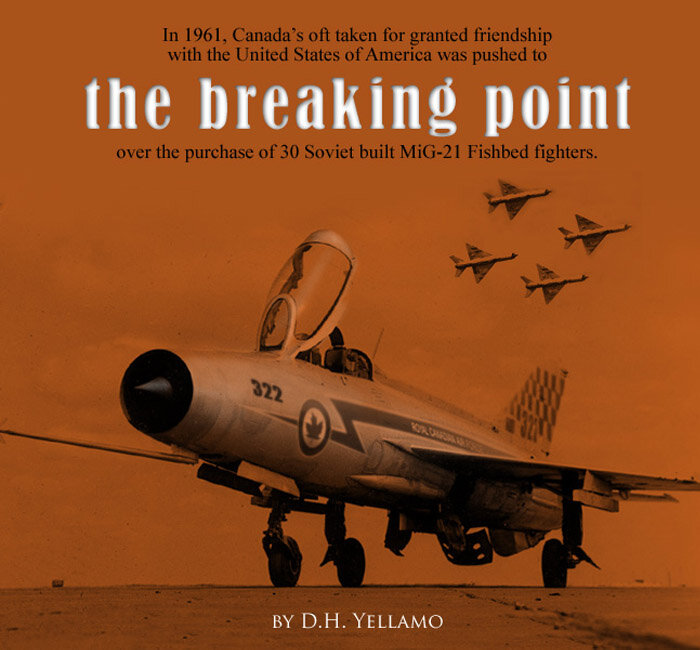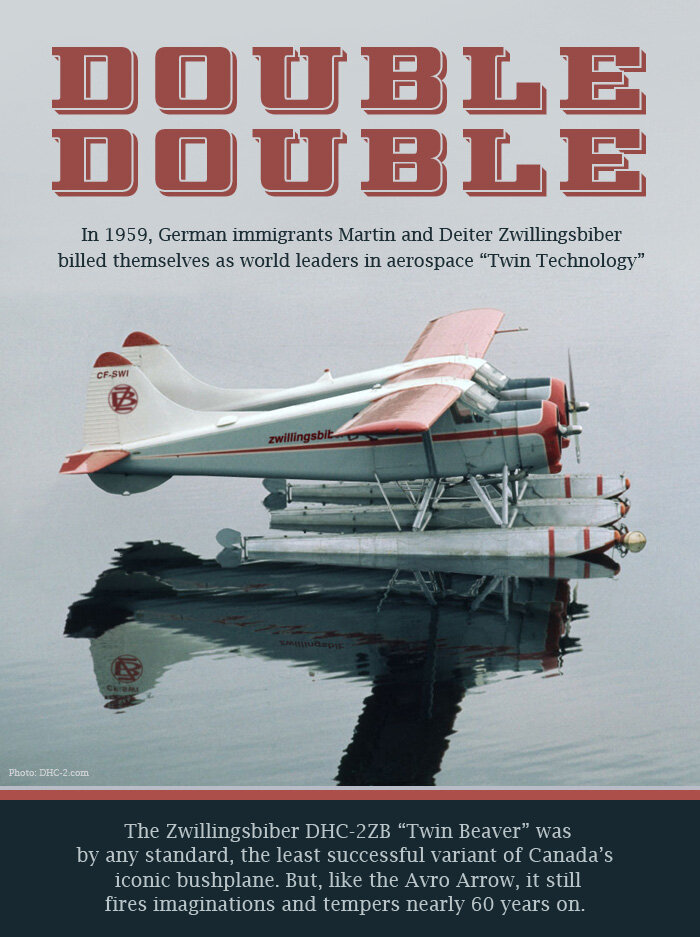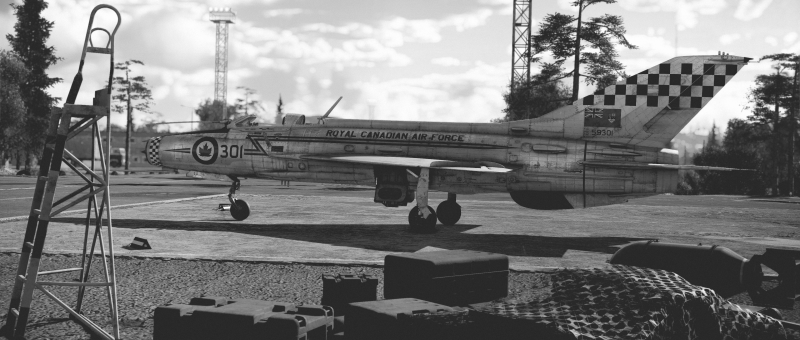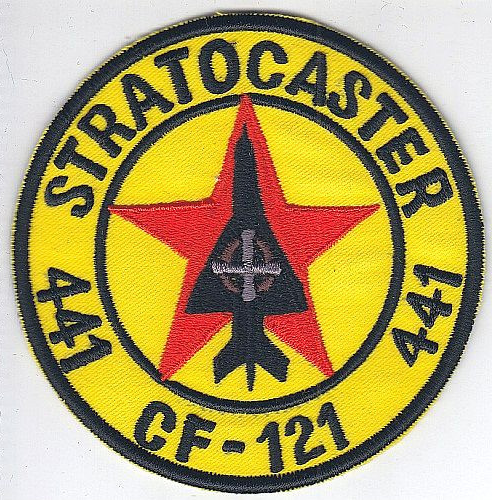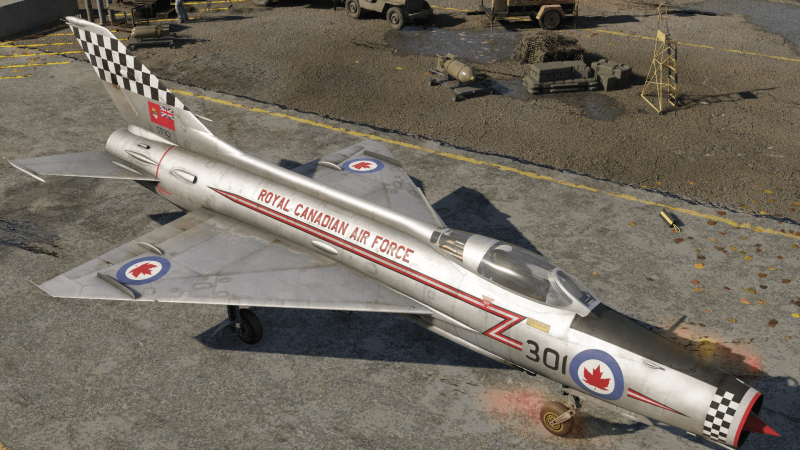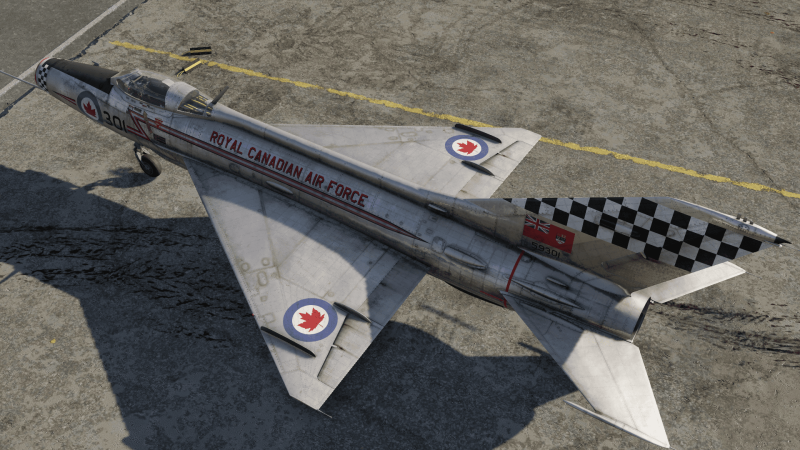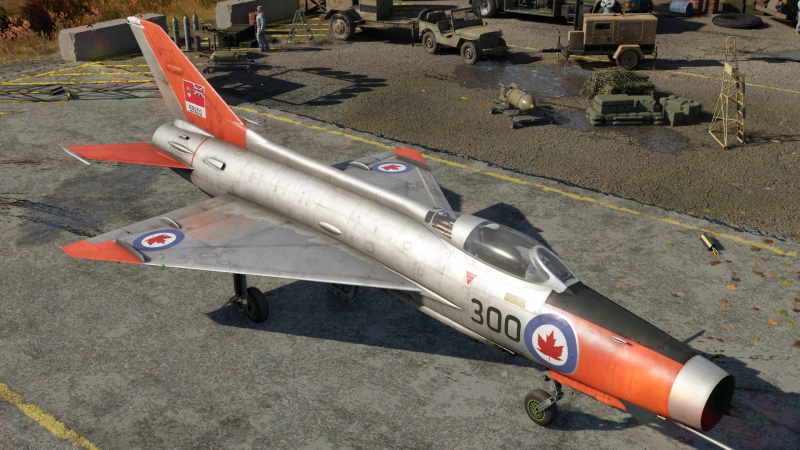THE BREAKING POINT — MiG-21 Redhawks of the RCAF
First Published April 1st, 2011 April Fool’s
October 31st, 2002, right wing blabbermouth and two-time Republican presidential nominee hopeful, Pat Buchanan misguided by a knee-jerk notion that Canada was a cesspool of anti-American “scentiment” referred to our country as Soviet Canuckistan. Half the country was quietly infuriated as Canadians are wont to be, while the other half was amused in a elitist sort of way. From that point on, the snarky sobriquet has been attributed to Buchanan by nearly all news agencies, but he in fact was not its originator.
Buchanan was in fact quoting his old boss - Richard Nixon, for whom he was a senior political advisor during his years as president. However, it was not President Nixon who was so angry with Canada, but rather Vice President Nixon back in 1960 at the height of the Cold War, and though Canadians were incensed then, I have to admit... he had a point. Buchanan would remember the nasty spell of hemispherical winter that fell upon Canadian-American relations at the beginning of that decade for he was a Journalism student at Columbia University at the time. In fact, he would be so outraged by the incident that, in 1962, he would write his Masters' thesis on the expanding trade between Canada and Cuba.
The political maelstrom that set Canada against America back in 1960 lasted not much more than one year but it took nearly a decade for heads to cool off and for relations to return to normal. Variously referred to by American media as “The Stab in the Back-yard”, “The Fishbed Flap” “The Redhawk Incident” or more ominously “The Canuck Invasion Crisis”, the events of that year brought Canadian-American relations to the breaking point. There were members of Congress in Washington who were ready to sanction Canada and there were commanders of the United States Air Force who were ready to go toe to toe with the RCAF. The commander of the Strategic Air Command, General Curtis Lemay took it even farther when he offered "My solution to the problem would be to tell those frozen Canuck bastards frankly that they've got to draw in their horns and stop their aggression or we're going to bomb them into the stone age."
In the early Fall of 1960, like a ferocious Arctic front, news that the Royal Canadian Air Force had made a secret purchase of 30 state-of-the-Soviet-art MiG-21 fighters to replace what would have been a deployment of the production model Avro Arrow interceptor swept across America. Americans from coast to coast were stunned and fears that Communist influence had spread to their northern border were rampant. Across America, anti-Canadian rhetoric was boiling over and people began to cut down maple trees in protest from Maine to Wisconsin. In one act of retaliation, three beavers were executed by pistol on the lawn outside the State Legislature in Frankfurt, Kentucky.
Most Americans and indeed many Canadians wondered what possibly could have motivated the Government of Canada and the Royal Canadian Air Force to so obviously challenge the here-to-for sleeping giant that was the United States of America. To understand the complexities and emotions surrounding the purchase (which became known as the Redhawk Program) we have to go back to 1953 and the beginnings of a national dream called the Avro Arrow.
The Avro Canada CF-105 Arrow was a delta-winged interceptor aircraft, designed and built by Avro Aircraft Limited (Canada) in Malton, Ontario, Canada, as the culmination of a design study that began in 1953. It was bold, elegant, gorgeous in a post-war sort of way and oh-so-Canadian. Considered to be both an advanced technical and aerodynamic achievement for the Canadian aviation industry, the CF-105 held the promise of Mach 2 speeds at altitudes exceeding 50,000 ft (15,000 m), and was intended to serve as the Royal Canadian Air Force's primary interceptor in the 1960s and beyond.
Not long after the 1958 start of its flight test program, the development of the Arrow (including its Orenda Iroquois jet engines) was abruptly and controversially halted before the project review had taken place, sparking a long and bitter political debate that still simmers today in web forums and dark chat rooms.
To most Canadians except the blind, the cranky and the revisionist, the Avro Arrow was a heartachingly beautiful and breathtakingly futuristic symbol of a nation imbued with a new technological persona. Feeling the thrill of standing at the very edge of scientific advancement, Canadians were abruptly yanked backwards from the precipice the day the Arrow program was cancelled. Though Canada's aerospace industry today is one of the most successful in the world, many Canadians who were alive that day still feel the sting.
The controversy engendered by the cancellation and subsequent vandalistic destruction of the aircraft in production, remains a topic for debate among historians, political observers, industry pundits and maple-flavoured crackpots. This action effectively put Avro out of business in a heartbeat and scattered its highly skilled engineering and production personnel across engineeringdom. The incident was a traumatic one... and to this day, many mourn, nay weep for the loss of the Arrow.
Though surely the Avro employees and support workers suffered the greatest catastrophic implosion of their dreams and most alacritous evaporation of their livelihoods, the pain of failure and urge to strike-out at someone responsible impacted the officers and senior bureaucrats at the Department of National Defence's Directorate of Systems Procurement in Ottawa with equal force. It was here, on the creaking wooden floors of DND's Hunter Building on O'Connor Street that the idea of an all Canadian, all-weather, long-range fighter interceptor was put forward. The men who worked on the fourth floor directorate became known as the“Hunter Boys” - to a man were air force veterans of the Second World War - pilots, navigators, intelligence men.
The butchering of a dream. Rumours of an impending cancellation of the Avro Arrow program had been in circulation and written about for months leading up to the decision to end it. Still, many Canadian were shocked at the announcement. In a matter of days, 14,500 Avro employees were out of work as well as 15,000 additional workers down the Arrow supply chain. Within two months of the project cancellation, all aircraft, engines, production tooling and technical data were ordered scrapped. Officially, the reason given for the destruction order from Cabinet and the Chiefs of Staff was to destroy classified and "secret" materials utilized in the Arrow/Iroquois programs. The action has been attributed to Royal Canadian Mounted Police fears that a Soviet "mole" had infiltrated Avro, later confirmed to some degree in the Mitrokhin archives. However, many mid- and high-level bureaucrats at the Department of National Defence's Directorate of Systems Procurement were convinced that American political pressure had been strongly applied to get the Canadian project cancelled in order to sell new the F-104 and F-101 fighters to Canada - then one of the largest air forces in the world. Their disgust at this apparent meddling in Canadian affairs led many to lobby hard for European or even Eastern Bloc fighter aircraft.
Related Stories
Click on image
The "Hunter Boys” looked upon the Arrow program as parents would look upon a child - albeit an overweight, underperforming child who spent his inheritance like King Farouk on a bender. When the program was canceled, it was to the “Hunter Boys” like the death of baby Charles was to the Lindberghs - devastating, final and buried before they knew what hit them. Like the Lindbergh Baby case, culprits were sought to hang the blame on. Some believed it was Prime Minister Diefenbaker's personal decision, a few in the inner circle believed that then Minister of National Defence, George Pearkes, was being blackmailed by an East German Mata Hari and cabinet courtesan by the name of Gerda Munsinger (this would be proven completely wrong in Munsinger's later autobiography "My Life Under the Tories"), but the “Hunter Boys” had their own culprit - the American military industrial complex (as it would become to be known after Eisenhower's farewell speech).
The Americans were not fearful of the Arrow's promised abilities (in fact they laughed at a reporter's suggestion they might consider buying Canadian) for they had aircraft of equal or better performance. What the Americas wanted was not Canadian technology, but the Canadian market for military aircraft. Canada had at the time one of the largest air forces in the world with scores of large bases from Newfoundland to Vancouver Island and hundreds of fighter aircraft and hundreds more utility and transport aircraft. If Canada took to building its own airplanes to replace the aging Sabres and then got it into its thick northern head to build aircraft of all types, billions of 1950s dollars would go into the Canadian economy and not the one south of the border.
How to anger a Canadian. This photo purportedly shows President Dwight D. Eisenhower and Vice-President Richard Nixon reacting to a question from a Canadian reporter during Eisenhower's visit to Ottawa on July 21st, 1958. His question: " Mr. President, would you care to comment on the fact that many Canadians now believe they have the world's most advanced military aircraft in the CF-105 Avro Arrow and that the United States might consider purchasing a number to equip some of your units." The laughter could be heard all the way to 24 Sussex Drive and all the way to 2011.
It was their certainty that the promise of the Arrow was slain by corporate decree and that the defiling of her beautiful white corpse can been carried out at the insistence of malevolent corporate and political captains in Washington, that led the “Hunter Boys” to seek a form of revenge so daring, so complete that it would touch every American. They would set in motion a plan to purchase replacement fighters, not from the United States, not from Western Europe, but from the Eastern Bloc. Led by the aptly named Air Commodore Frederick Roe, DFC, the “Hunter Boys” met secretly in late March in the darkened tap room of the Bytown Inn just across O'Connor Street from the Hunter Building. These meetings came to be known as the “Labatts Conspiracy”
In a matter of a couple of weeks, they had set in motion a plan to engage key members of the Soviet regime. Low-, mid- and high level talks and meetings were sought with RCAF brass and then Soviet leaders and by June of 1959, the procurement team had made entreaties to diplomats and party officials at the Embassy of the Soviet Union in Ottawa's Sandy Hill.
In late August of 1959, a large team of Canadian officials including A/C Roe, top RCAF brass, test pilots, aeronautical engineering experts from the Paul Kissmann Institute flew by RCAF Northstar to West Berlin. From here they were secreted through checkpoints and to the East German Air Force base at Holzdorf in Schleswig-Holstein. There, they were given unprecedented access to the heretofore secret MiG-21F (NATO codeword Fishbed-B) with a full demonstration by an up and coming Soviet test pilot by the name of Yuri Gagarin. Though the progenitor of the Fishbed-B, the Ye-4 (for Yedinitsa - a Russian word meaning "One-off" or single prototype) had made its first public appearance during the Soviet Aviation Day display at Moscow's Tushino airfield in July 1956, little if anything was known about the type. The Canadians were concerned about the MiG's short range but were very impressed with its Mach-2 top end, and its acceleration to the mach. Interpreters for the delegation translated Gagarin's grinning comment after the show as "MiG-21 is lightning bolt across Mother Russia. MiG-21 runs like a scalded dog on Nevsky Prospekt."
The flying display led in turn to the highest level talks yet - between First Deputy Chairman of the Council of Ministers of the Soviet Union, Anastas Mikoyan (no less than brother of the Artem Mikoyan, one of the USSR's greatest aircraft designers) and Prime Minister John George Diefenbaker of Canada. Though the meetings were secret in every way, it was deemed a good idea to hold them in plain sight and so the high level meeting took place on the main floor of the New technologies, New World Showcase - a trade fair held that November in West Berlin. Though Diefenbaker lacked the natural charm and ease of Mikoyan, both men were born in farming country far from their nations' capitals and they connected on a personal level. That day, at the Soviet Union's vast Gallery of Progress and Household Joys, amidst the 400lb 9" colour TVs, steam powered lawn mowers, atomic ovens and toasters the size of tombstones, a deal was struck.
Prime Minister John Diefenbaker shoots a withering look of anger at a Russian Doukhobor photographer who captured him in discussions with Anastas Mikoyan (left) and Segei Volchenkov at the Mikoyan Gurevich display at the Halle von Technologien during the Neue Wissenschaft, Neue Welt technology showcase in West Berlin, November 1959. “Dief the Chief”, as he was known by Canadian wags, was very careful to keep a low profile while negotiating the purchase of Eastern Bloc technologies such as Soviet-built MiG-21 fighter aircraft. The photographer "Nudi" Nudistavinka was manhandled by KGB agents and his camera confiscated - the photo, which surely would have alarmed the United States at the time, would not be made public until the fall of the Soviet Union thirty years later. Photo by Peytor Nudistavinka
Canada would receive 30 brand spanking new, state-of-the-Soviet-art, all-weather MiG-21 interceptors straight off the assembly line as well as spares, technical assistance and training, tools, jigs, support equipment and a whole lot of secrecy. It was the largest Soviet-Canadian weapons deal since the Lend-Lease program sent Canadian-built Hawker Hurricane XIIs to Russia in the 1940s. It has never been clear what the Soviets were to receive in payment, but in 2012, the "top secret" status of the files will be removed and the figures will no doubt be made public. It was rumoured at the time, that the Soviets were pushing for bases in Yukon and Labrador, but these were never granted. The Canadians needed aircraft and revenge, but not Soviet allies. 441 Squadron was selected for the Redhawk Program for the high quality and experience of its pilots.
And so, like the inevitable conflict that follows an arms race, the agreement ratified that day set in motion a series of steps that would strain Canadian-American relations for decades. The speed at which all this happened was fueled on Canada's end by Air Commodore Roe's revenge-lust and on the Soviet side by unbridled and unfounded glee at the prospect of extending their influence to the 49th parallel. The Reds had somehow convinced themselves that the Canadians were turning socialist - bolstered by their willingness to shop the Soviet weapons market and the fact that Canada was in the throws of socializing their entire national health care system. They embraced this delusion like a crackhead leaps for joy at a police bait car. How wrong they were!
Over the next three months, 30 shiny new MiGs were selected from the line at the Mikoyan OKB plant outside Moscow, disassembled, crated and shipped by rail car to the White Sea port of Severodvinsk. Throughout the months of February and March of 1960, a series of rusty Russian freighters were loaded with anywhere from one to 6 crated aircraft under the cover of darkness (not a hard thing to achieve at that latitude in February). One by one, they weighed anchor, and shaped a course north and then west over the top of Scandinavia and out to the open sea, bound for the east coast of Canada and the Bay of Chaleur. Each ship was secretly shadowed by a Russian submarine all the way.
Americans should have been tipped off very early on to the discussions between the USSR and Canada over the acquiring of MiGs when Nikita Khrushchev let it slip during the now-infamous 'Kitchen Debate" of June 1959. While arguing face to face about the relative qualities of technologies from East and West, Khrushchev was insulted by Nixon's insistence that Americans were far ahead of the Soviets in modern conveniences. He was overheard to whisper to Nixon at one point, "In Kalinovka (his birthplace) we have a saying - Beware the mule next door, for he sleeps in your barn.” Perplexed reporters hounded the Premier for days trying to determine the meaning of the old Russian saw.
Off-loading by night at the port of Bathurst, New Brunswick, each ship disgorged its crated mysteries onto CNR flatcars under the supervision of Air Force MPs. The shrouded cars were then coupled with a locomotive and sent on a two hour overland journey south to RCAF Station Chatham - the base for the fighter OTU for Canadian Sabres. Here under airtight security, Mikoyan technical representatives supervised the re-assembly of the fighters as they arrived, and a team of four pilots from the Luftstreitkrafte der NVA (East German Air Force) carried out night-time flight training with pilots of 441 Squadron who had come home from Marville, France where they had been stationed. Most Anglo and Franco pilots had been dispersed to other units and the roster was filled out by Canadians of Slavic, Balkan and even Greek ancestry. This was done because the hastily purchased MiGs had instruments that were calibrated in metric units and displayed in the Cyrillic alphabet. It was thought that those who had grown up around this alphabet would have an easier time adapting.
Over the next two to three months, flight training proceeded apace and by late June 1960, crews were ready for a ferry flight to their eventual home base of Cold Lake, Alberta. But first they had to pick a name for their new fighter aircraft, which the RCAF was calling the CF-121. At this time, the RCAF aerobatic demonstration team, the Golden Hawks were stationed at the other side of the base. The Squadron Commander, S/L Stefan Swillka, inspired by the Hawks, named the new type the Redhawk. More creative squadron pilots nicknamed it the "Stratocaster" or "Strat", a name that paralleled their German instructors who called it the “Balalaika”.
In the USSR, Soviet MiG-21 pilots had lovingly nicknamed their new MiG-21 fighter the "Balalaika" in reference to its angular plan form's resemblance to the Russian stringed musical instrument. Of course, 441 pilots needed something a little less Ruskie, and a little more Rock 'n Roll. American rock legend Buddy Holly was a favourite of many young Canadian fighter pilots of the day. RCAF fighter pilots had a particular connection to the Lubbock, TX rocker for he died in an airplane crash on February 3rd, 1959 just two weeks before the Avro Arrrow was cancelled. 441 pilots took to calling the CF-121 Redhawk the “Stratocaster” after Holly's Fender Stratocaster guitar seen here.
Before dawn on June 23rd 1960, 9 pairs of CF-121 Redhawk fighters spooled up on the flightline at RCAF Station Chatham. (8 fighters would remain in storage for until needed and the last two had not yet arrived by sea). Though ramp lights were kept off for secrecy, ground crew could see for the first time the freshly applied 441 Silver Fox Squadron checkerboard tail markings, aircraft numerals, RCAF titles and roundels. Great rivers of superheated exhaust billowing from their shrieking Tumanskii turbojets turned the mid-summer pre-dawn ramp into a noisy inferno. Led by S/L Swillka, each gleaming fighter lurched forward in turn, wheeled left, and taxied in line to the end of runway 25. There, in pairs, Red Fox 1, Red Fox 2, Red Fox 3 and the rest pushed the throttles past the detents, lit the burners and thundered down the runway to lift off into history. They would transit from Chatham direct to RCAF Station St. Hubert near Montreal. Unable and unwilling to fly over or even near Maine, the ferry flight would sorely test even the ferry range of the heavy, gas-sucking fighter. Their course would take them north to Trois Pistoles on the south shore then southwest following the mighty Fleuve St. Laurent south of its shoreline. Radio silence was to be kept the entire way.
An hour later, right after sunrise, as commuters were just beginning to bustle into the city of Montreal, nine pairs of MiGs began letting down from 28 thousand feet toward St. Hubert with the sun rising like a brilliant white disc behind them. While the tower was expecting them, the radar station at RCAF Station Victoriaville was not. The 18 strange fighter aircraft had been tracked all the way from St. Percival Monitaire. A curious technician and avid aviation buff, stepped out to the balcony surrounding the radar dome with high-powered binoculars and trained them on the pairs of contrails trailing back to Quebec City hoping to get a glimpse of the fast movers that kept silent on the radio.
It took nine pairs of MiGs passing overhead on the letdown until he had convinced himself that he was indeed looking at the same MiG fighters he had seen numerous times in Flight magazine and in training films. He could not understand what he was looking at but he knew what he had to do. He dashed inside and sounded an alarm that would send a pair of stand-by interceptors from their ready-hangars and launch them to intercept.
The nearest base equipped with defensive fighters was in fact St Hubert, where Swillka was leading his wing man into land. At two miles out he could see two CF-100 Canuck fighters emerge from the readiness hangar near the threshold of Runway 25, hell bent for leather. At one mile, he realized that they were about to turn directly onto the the very same runway he was about to land on. Powering up he banked left and took his wing man and eventually the two Redhawks of Red Fox 2 into a circle south of the field.
In the early morning of June 23, 1960, a Montreal aviation enthusiast named P.J. Ninob on his way to work was attracted by sirens sounding at RCAF Station St. Hubert in the community of Longueuil east of Montreal Island. His Leica camera was always at the ready and he pulled over to the side of Chemin de la Savane where it edges closer to the threshold of Runway 06. Getting out of his car, he was drawn to a circling aircraft south of the station - a type he had never seen before. To his left, a pair of CF-100 Canuck all-weather fighter aircraft of 425 Squadron, les Alouettes, were at the same time thundering down runway 24 converging on his position on the fence line. With little time to react, Ninob managed to shoot only a single somewhat blurry photo of the lead CF-100 and the strange new fighter that was circling to the south. It was the last frame on his roll, but it was all he would need. However, MPs from the base stopped him before he got 100 yards and confiscated his camera. He would not get it back and this photo would not be published until the story broke in the press later that summer. Photo via Ninob Family Archive
Just as the pair of CF-100s from 425 Squadron lifted from the runway, radio silence was broken by the tower and after some Dr. Strangelove-style convincing, the two "Clunks" formed with Swillka and escorted them back into the circuit. All 20 aircraft landed safely and without further incident. The event, that the RCAF had kept so secret, was recorded by a civilian on his way to work, but that photo would not be made public for few months until after the story broke .
From St. Hubert, the short legged MiGs hopped across the country with fuel stops at RCAF Stations at North Bay, Goderich, Port Arthur (civilian), Portage La Prairie (where they over-nighted), Moose Jaw and and finally RCAF Station Cold Lake, Alberta, where they would begin exercises with in a few days. To this very day, hanging on the wall in the Flight Commander's office in Portage la Prairie is a "Remove Before Flight" streamer from one of the pitot tubes. The ground start crew, being somewhat unprepared or trained to handle the MiG, removed it and "forgot" to place it in the on-board bag. It is one of the few reminders we have today of the Redhawk Program.
June 24rd, 1960. CF-121 Redhawk (59-319) arrives for the first time at her new base at RCAF Station Cold Lake, Alberta flown by Flight Lieutenant Alki Erdos (Uncle of our own Rob Erdos). Because the instrumentation aboard the hastily purchased Soviet fighters was calibrated in metric units and displayed in the Cyrillic alphabet, only Canadian pilots from Ukranian, Balkan and Slavic backgrounds, and a smattering of Greeks were recruited. 441 Redhawk pilots Flight Lieutenant Marian "Donuts" Timishenko and Flying Officer Marco 'Rocky" Sedimentchuk both hailed from nearby Glendon, Alberta. Soon the 121s would be repainted in the red lightning flashes they would carry until the end of the program. Redhawk 59-319 would be the only example that was destroyed when it ran out of fuel south of Cold Lake during Exercise Perogy. Known as the Glendon Glider, it would come to rest in a farmer's field near the town of that name.
The base was far enough from prying eyes and associated with the immense Primrose Air Weapons Range. The heavily forested terrain of this facility resembles Eastern European topography. With its unrestricted airspace, Cold Lake's Primrose Air Weapons Range was considered to be one of the finest combined air operations training ranges in the world. It would be over this rugged and unpopulated 12,000 square kilometer playground that Swilka and his Red Fox formations would train and exercise over the next few of months. At the end of each day, they would retire to their mess, nicknamed "The Den" to discuss tactics and share the knowledge of MiG-21 care and feeding. All loved the low altitude, supersonic dashes they made just above the tree tops. The aircraft handled well and accelerated like a rocket, but they all came to dislike the poor rearward visibility, and above all the short time aloft when afterburners were lit. If a Redhawk had consumed more than two thirds of its onboard fuel, the centre of gravity shifted dangerously aft. This could cause a dangerous tendency toward uncontrollability. Aggressive handling by experienced RCAF pilots saved more than a few losses of control, and overall the pilots had to be more delicate the more fuel was expended - a bad thing if you were attacked near the end of your flight.
The first big exercise at Cold Lake was Rolling Cossack in late July. This pitted 441's Redhawks against 433 squadron's CF-100 two seat interceptors. With a second pair of eyes in the back, the Clunks proved reliable and up to the task of finding and dealing with Redhawk attackers. The far greater experience on type for the 433 Gigalos was the reason they dominated. Regardless of the outcome for 441, they gained deep experience in flying and fighting with the Redhawk.
Exercise Rolling Cossack. A rare view of twelve 441 Squadron Strats assembled at Cold Lake, Alberta in the late July of 1960 shows nearly the entire squadron readying their fighters for Exercise Rolling Cossack. Rolling Cossack would be the first full squadron exercise pitting their new interceptors against elements of the other Cold Lake-based interceptor squadron - the 433 Gigolos, equipped with the CF-100. The test proved the reliability and simplicity of the utilitarian Soviet fighter, but it also demonstrated its remarkably short legs and a vicious tendency towards uncontrollability should more than 2/3 of its fuel be consumed. By the end of the five day exercise, 433 Squadron Gigolos had fended off nearly all “attacks” by the 441 Red Foxes
One of the few clear photographs still in existence of the CF-121 Redhawk or “Stratocaster” in full late deployment markings which replaced the Chatham markings in early August. So eager were the Soviets to sell Canada these fighter aircraft, that the Canucks actually received 30 of the first 93 MiG-21F machines ever made. It was a stunning misread of the possibilities of a transpolar alliance between Canada and the Soviet Union. RCAF Photo
Redhawk 121301 at Cold Lake. Photo: Fluttu
It was the second major training exercise, Perogy, conducted in late August that caused a major crisis between Canada and the United States. Now, the RCAF knew it was a matter of time before the US learned of the Redhawk Program, in fact they were surprised that they had managed to keep a lid on it so long. But during the Perogy exercise, two major events happened - one of the Redhawks finally fell victim to its desire to consume fuel and flamed out south of Cold Lake near the small hamlet of Glendon, Alberta.
RCAF pilots learned about Redhawk's miserable range the hard way. During Exercise Perogy in September 1960 a newly painted CF-121F (59-319) lies belly to the wheat outside Glendon, Alberta. Flying Officer Iggy Gouzenko flamed out while buzzing a Glendon farmhouse. Though the Redhawk was removed immediately, it would return nearly thirty years later in the form of a giant perogy on a fork. RCAF photo
The other more dramatic event was discovery and the end to the secrecy. A four-ship of 441 Redhawks separated from Exercise Perogy to train for a display the Canadian National Air Show in Toronto the following week. It was to be the public debut of the new fighter. Red Fox 21, the 4-ship formation, was photographed by an American serviceman on a camping trip to Alberta. Within days, the jig was up. The grainy photograph of four Redhawks in a tight formation streaking low past a hill top near Moose Lake was pasted onto the front page of every newspaper in America, Canada and Europe. To say the least, everyone save the “Hunter Boys” and the Soviets were stunned.
A rather poor shot of Red Fox 21 - a four-ship formation of CF-121 Stratocasters from 441 Squadron inbound to RCAF Station Cold Lake during Exercise Perogy photographed by an American camper at Moose Lake Provincial Park about 40 km southwest of RCAF Cold Lake. The photographer, a vacationing USAF Sergeant named Karl Tattler from March Air Force Base, California, had climbed a hill to photograph the lake when he caught the formation rocketing past at extreme low level. He knew exactly what he was looking at, crossed his fingers that the photo had been clear, packed up and headed south immediately. The following week, the photo found its way to the front page of the Los Angeles Mirror News on September, 8 1960.
The "Moose Lake" photo as it became known, appeared in the Los Angeles Mirror News the following week and set in motion a firestorm that would culminate in the death of the Canadian CF-121F Redhawk program - many saw it as just more American pressure brought to bear on Canadian internal business - some called it the “Destruction of the Arrow-ski” Photo: Mirror Archives
The New York Times printed the headline "Canadian Plot Foiled - US Airman Saves Nation", while the Chicago Tribune ran with a simple "Canadian Communist Shocker" and the Washington Post used a double entendre "Bordering on Evil - Soviet Fighters Amass at Border". Canadians and American diplomats were scrambling to understand what had just taken place. Security focus for the US turned 180 degrees from Cuba to Canada in one day. For the next week, U-2 flights were ordered day and night over Canadian military bases and Canada was unable to stop them. National Guard Units from Maine to Montana were mobilized and infantry units, mechanized units, and Bomarc SAM missile batteries began to pile up along the 49th Parallel.
In his emergency speech to the Union on September 24th, 1960, President Eisenhower blamed the entire diplomatic quagmire on the Military Industrial Complex, a phrase he would use again in his more famous goodbye speech in 1961. It was his Vice President, Richard Nixon, who spat more acidic invective and inflammatory comments. His rather creative and famous "Soviet Canuckistan has dropped the Iron Curtain along the 49th and the United States of America will tear it down and wipe Canada clean with it." sent massive shivers rippling through Parliament.
The US sent a delegation that included all members of the Joint Chiefs of Staff and Secretary of State Christian Hirter, to Ottawa in October and they laid out a rather simple two point ultimatum. Get rid of the MiGs by February 1961, Sack the those responsible. Canada, as Canadians do, promised to have a feasibility study done but first would have to create a Parliamentary Inquiry just a soon as Members of Parliament got back from the Christmas recess which began on November 3rd and ran until January 16th. Then they would look into the matter and most likely create an Ombudsman who would look after American complaints of this nature. Once that person was chosen, and a budget appended, work could begin on designing a process for assuring compliance with national communication standards as out lined by Treasury Board. Then and only then could headway be made in addressing the shape and size of the meeting table and seating plan for delegates from both countries.
Once all the mechanisms were in place to create a "transparent" process and the highest levels of "accountability", mid-level bureaucrats would take over the day-to-day mechanics of the process and free politicians up to deal with issues of governance and rule of order. This mind-numbing bureaucracy and attention to the minutia of process had the narcotic effect of slowing down the pressure, taking the edge off the wrath and wearing down even bullies like General Curtis Lemay.
By January of that year, President Kennedy had been inaugurated and the promise that was Camelot warmed negotiations and opened doors between both nations.
The term "shuttle diplomacy" was first coined during the Redhawk Incident, as delegations flew back and forth between Washington and Ottawa. By mid-May of 1961, rhetoric was cooling down, deals were struck and the process of untangling the diplomatic knot had begun. If Canada guaranteed the end of the Redhawk Program by mid-summer, the united States would back demobilize troops along the border, allow some America aircraft to be license-built in Canada, and seriously consider socializing their health care system.
Perhaps the best photograph extant of a Canadian CF-121F Redhawk (59-322) - taken from the CAF website above. In war exercises, the Soviet fighter was overly visible during dogfights due to its polished aluminum finish. The poor grade of Soviet aluminum caused rapid surface corrosion which made the Redhawks seem painted in chalky gray by the time they were taken out of service. This had one benefit - to make the fighter less visible. The one positive legacy from the Redhawk program was the experience with low-vis air-superiority paint - which would eventually be applied to the CF-18 to great success. It is believed that this photo dates from early 1961 just prior to the cancellation of the entire program. CF Photo
Forty years later, Canada would repaint one of their 441 Squadron CF-18s to commemorate the Redhawk during the 75 Anniversary of the RCAF. CF Photo
Today, the holy grail of patch collectors remains undeniably the CF-121 Stratocaster patch and the short-lived tongue-in-cheek 441 unit patch with the squadron motto "Stalk and Kill" written in Russian and the Cyrillic alphabet. Recently, an original copy of the Strat patch sold for more than $650.00 on Ebay. Photo courtesy Canada Aviation and Space Museum.
The only known existing Stratocaster patch, now considered the Holy Grail of patch collecting, has since sold for $1,200.USD at a military auction house in Great Britain.
Though the United States demanded the immediate withdrawal of all Redhawks from North American soil, they asked that one CF-121 be delivered to Edwards AFB in California for test and evaluation.
While all this was going on, 441 Squadron pilots continued to fly the Redhawk to gain experience of the Soviet machine they knew would pay off in the years to come. The flying was curtailed throughout May and June, and then the program was abruptly cancelled, though unlike the Arrow, everyone knew it was coming - including the Soviets. The 441 pilots were in demand across the west to lecture NATO crews on the merits and drawbacks of the MiG-21. The Soviets kept a low profile throughout the turmoil, hugely embarrassed by their naive and somewhat gleeful misread of the possibilities of a trans-polar alliance. The last two Redhawks, which were still on their way by freighter, were never delivered.
The Hunter Boys were revered within the halls of DND headquarters, but an example was to be made. Roe would retire into oblivion and all the younger officers were manning radar screens on the DEW line by summer's end.
It was the darkest time in Canadian-American relations since the war of 1812, but we became closer for it.
Of the 30 Redhawks, 27 were eventually sold back to the Soviet Union. The RCAF kept one for future display and told the Russians that two others had crashed during training. In fact only one had crashed (landed) - the Glendon Glider. The third had been secretly trucked to Edwards Air Force Base in California in the summer of 1961. Here, former 441 Squadron Redhawk (59-328) was test flown by Edwards pilots to learn the capabilities of the Soviet fighter. RCAF pilots came down to train and brief the Americans and thus began the tradition of Canadians attending the USAF Test pilot School. Two of Vintage Wings own pilots, Chris Hadfield and John Aitken, have been the beneficiaries of this tradition - and all because of Commie fighter! Photo USAF
When the Redhawk program was canceled, 441 Squadron was one of the first units to be assigned to the new Lockheed CF-104 Starfighter. Here, a 441 Squadron "colour bird" painted with the unit's addiction to checker board markings forms up with colour birds from 439 Squadron Sabre Tooth Tigers and 421 Squadron Red Indians. Their (441's) knowledge of the performance and systems of the MiG-21 would make the RCAF/CAF Starfighter Squadrons the most experienced and formidable in all of NATO. 441 Squadron pilots who flew the Redhawk were distributed throughout Number One Air Division in Western Europe, making Canadian units and their pilots the envy of all others. CAF photo
Today, very little remains of the 441 Squadron Redhawk experiment with MiG-21 fighter aircraft. Because of the secret nature of most of the squadron's operations using the Strat, few images were ever released or even photographed for that matter. When the program ended in near political disaster, 27 of the 30 purchased airframes were hastily returned to the Soviet Union. Of the 27, three (59-324, 59-327 and 59-330) were offered to the Democratic Republic of Vietnam. Two were shot down by American fighters near Hanoi, and one (59-324) survives today - in outdoor display at the People's Garden of Suffering and Victory in Hanoi. Sun and heat have weathered the DRV markings and brought out the faintest hint of her old RCAF 441 Squadron paint.
Another view of the former Canadian CF-121F Redhawk at the People's Garden of Suffering and Victory in Hanoi with happy tour guides presiding. The old RCAF lightning flash can still be seen as well as a USAF “star and bar” indicating that possibly this MiG has a Vietnam War kill to its credit - the final irony. When in Canadian service this MiG carried the "last-three" numerals 324 (see previous photo). We wonder if it is more than a coincidence that in the air force of North Vietnam she carried the same number. Photo pj-riccio2006 on flickr
A Model of RedHawk CF-121-324. To this day, model builders worldwide find this brief period in Canadian air force history very compelling. At any International Plastic Modelers Society (IPMS) meet, you will always find examples of CF-121 Redhawks wearing their unique livery, like this example by Regina-based modeler Michael Evans. Photo: Michael Evans
A Model of RedHawk CF-121-322. Another fine example of the model makers kraft—it seems the Redhawk will live on in Canadian hearts forever, not so much for the aircraft itself, but for the memory of the time Canadians stood up against American meddling in our aerospace industry. Model and photo by Benoit Bonnier
Computer-generated images from the computer game War Thunder
Computer-generated images from the computer game War Thunder
Computer-generated images from the computer game War Thunder
Photo: Fluttu


